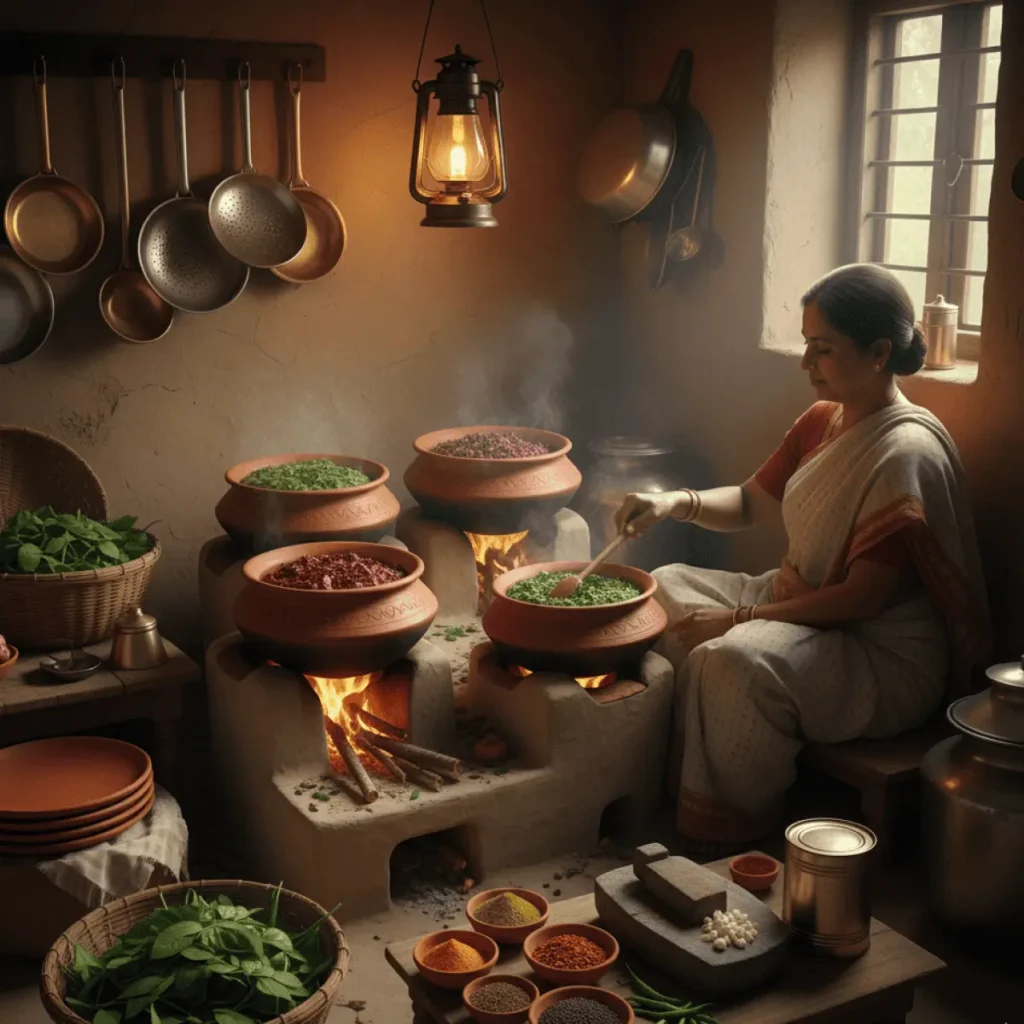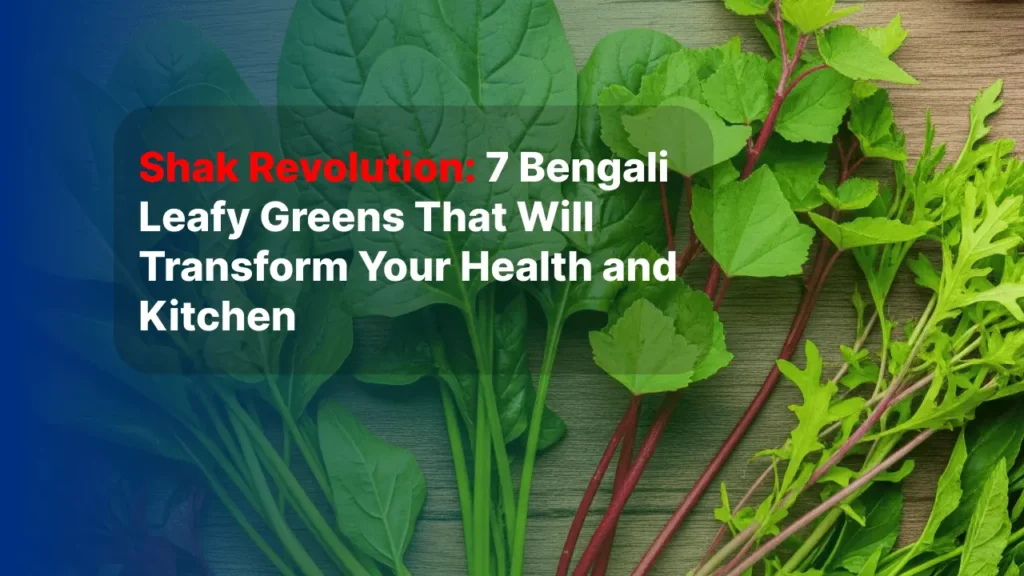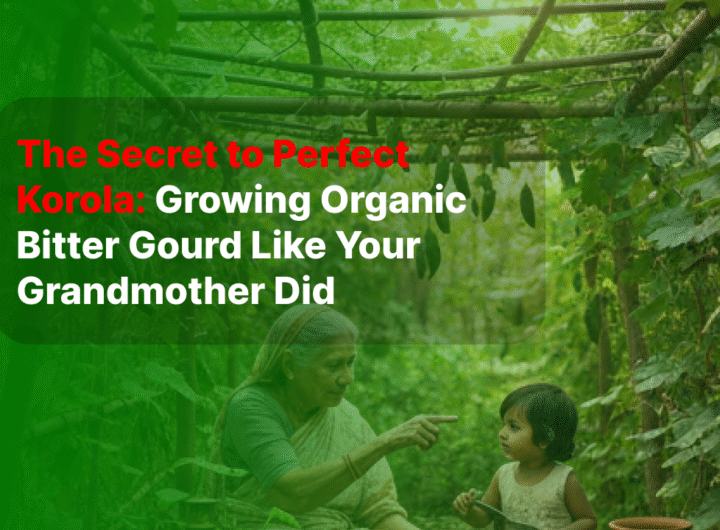Are you tired of boring salads? Do you crave vegetables with real flavor?
Bengali leafy greens pack more nutrition than supermarket spinach. They carry bold flavors. They connect you to ancient wisdom.
Your grandmother knew these secrets. She grew shak varieties that modern stores never sell. She understood food as medicine.
Why Bengali Leafy Greens Rule Your Kitchen

Shak varieties contain superpowers. They fight disease. They boost energy. They taste amazing when you know how to cook them.
Each Bengali leafy green serves a purpose. Some cool your body. Others warm you up. Traditional medicine meets delicious food.
Modern research proves what grandmothers knew:
- Higher iron content than regular spinach
- More antioxidants than expensive superfoods
- Natural detox properties for liver health
- Better mineral absorption due to traditional varieties
- Stronger disease resistance from diverse genetics
Years of analyzing health trends taught me something important. The best nutrition comes from traditional foods.
These organic spinach alternatives grow easily. They cost less than supplements. They taste better than pills.
Ready to revolutionize your health? Let’s explore 7 Bengali leafy greens that will change how you think about vegetables.
1. Lal Shak (Red Amaranth) – The Iron Powerhouse

Red amaranth leaves glow like jewels in your garden. They contain more iron than meat. They’re beautiful and nutritious.
Lal shak seeds grow this superfood easily. Plant them once. Harvest for months.
The red color signals high anthocyanins. These compounds fight inflammation. They protect your heart. They boost brain power.
Young leaves taste mild and sweet. Mature leaves add earthy depth. Both stages offer different culinary experiences.
Cooking tip: Add lal shak to dal. The red color creates beautiful contrast. Kids love the colorful presentation.
2. Palak Shak (Bengali Spinach) – The Traditional Champion
Bengali spinach tastes nothing like supermarket versions. It’s more flavorful. It’s more nutritious. It handles heat better.
These organic spinach seeds grow the real deal. This is what your ancestors ate.
Palak shak contains folate. It supports pregnancy health. It fights anemia. It boosts energy levels naturally.
The leaves stay tender longer. They don’t bolt quickly in heat. They produce continuously through the season.
Plant palak in cool weather. Spring and fall work best. Summer heat makes it bolt fast.
Want fresh spinach year-round? Succession plant every 2 weeks. You’ll never run out of fresh leaves.
3. Pat Shak (Jute Leaves) – The Silky Sensation
Pat shak leaves feel like silk between your fingers. They taste unique. They’re essential for authentic Bengali cuisine.
The same plant that makes rope produces these culinary treasures. Jute leaf seeds grow edible gold.
Pat shak contains mucilage. This natural compound soothes digestion. It helps with stomach problems. It’s like nature’s antacid.
Young leaves work raw in salads. They add interesting texture. Cooked leaves become silky and mild.
These plants love heat and moisture. They thrive when other greens struggle. They’re perfect for summer growing.
4. Lay Shak (Mustard Greens) – The Spicy Healer

Lay shak brings fire to your plate. These mustard greens pack serious flavor. They warm your body from inside.
Winter is lay shak season. Cold weather makes leaves sweeter. Heat makes them too spicy to eat raw.
Mustard green seeds connect you to Bengali winter traditions. Your ancestors survived harsh winters eating these nutrient-dense leaves.
The spicy compounds fight infections. They clear congestion. They boost circulation naturally.
Young leaves work in salads for brave eaters. Mature leaves need cooking to tame the heat.
Health boost: Lay shak contains glucosinolates. These compounds fight cancer. They support liver detox.
5. Red Indian Spinach (Paya Shak) – The Heat Lover
Red Indian spinach climbs like nature’s ladder. It produces leaves when other greens quit. It loves summer heat.
Paya shak seeds grow this amazing heat-tolerant green. It’s not related to regular spinach but tastes similar.
The red stems contain betalains. These pigments fight inflammation. They support heart health. They’re nature’s medicine.
This plant grows vertically. It saves garden space. It looks beautiful climbing fences and trellises.
The leaves stay tender in hot weather. They don’t bolt or turn bitter. They produce continuously all summer.
Space-saving tip: Grow paya shak up walls. You get maximum harvest from minimum space.
6. Soresa Shak (Mild Mustard) – The Gentle Giant
Soresa shak offers mustard flavor without the fire. It’s perfect for sensitive palates. It bridges the gap between mild and spicy.
These organic mustard seeds grow a gentler variety. It tastes like lay shak’s mild cousin.
The leaves look different from regular mustard greens. They’re rounder. They’re less serrated. They signal milder flavor.
Soresa works great for beginners. It introduces people to mustard greens gently. It builds tolerance for spicier varieties.
Children accept soresa better than lay shak. The mild flavor wins over young taste buds.
7. Bonus Green: Jute Mallow – The Summer Survivor
Jute mallow rounds out our magnificent seven. It thrives in blazing heat. It produces when nothing else grows.
This heat-loving green tastes mild and pleasant. It’s related to pat shak but different. It offers summer nutrition when you need it most.
The leaves contain vitamins A and C. They support immune function. They help your body handle heat stress.
Growing seasons matter. Different shak varieties prefer different temperatures. Plan your garden for year-round greens.
Growing Your Bengali Leafy Greens Successfully
Success with shak varieties requires timing. Each green has preferences. Match the plant to the season.
Cool season greens:
- Palak shak: Spring and fall plantings
- Lay shak: Late fall through winter
- Soresa shak: Cool weather lover
Hot season champions:
- Paya shak: Thrives in summer heat
- Pat shak: Loves hot, humid weather
- Jute mallow: Summer survivor
Year-round producers:
- Lal shak: Adapts to most seasons
Plant cool-season varieties early. Hot-season types wait for warm soil. Timing ensures success and continuous harvests.
Pro tip from my garden optimization experience: Stagger plantings every 2 weeks. You’ll have fresh greens constantly.
Cooking Secrets That Transform Flavor

Cooking method transforms Bengali leafy greens. Raw leaves taste different than cooked. Each preparation serves different purposes.
Quick sautéing preserves nutrition. It maintains bright colors. It keeps leaves slightly crisp.
Slow cooking with dal creates comfort food. The greens melt into creamy lentils. Flavors blend beautifully.
Mustard oil enhances flavor. It’s traditional. It adds depth and richness.
Garlic and ginger balance strong flavors. They aid digestion. They complement leafy greens perfectly.
Different shak varieties need different approaches. Tender leaves need gentle cooking. Tough leaves benefit from longer cooking.
Health Benefits That Will Amaze You
Bengali leafy greens deliver targeted nutrition. Each variety offers unique benefits. Together they create complete wellness.
Lal shak provides:
- Iron for blood health
- Anthocyanins for heart protection
- Folate for energy production
Palak shak supplies:
- Lutein for eye health
- Magnesium for muscle function
- Vitamin K for bone strength
Pat shak offers:
- Fiber for digestive health
- Mucilage for stomach soothing
- Antioxidants for cell protection
The combination creates synergy. Different compounds work together. The whole becomes greater than parts.
Want maximum benefits? Eat variety. Rotate different shak types. Your body gets complete nutrition.
Start Your Shak Revolution Today
Your shak revolution starts with quality seeds. It continues with proper planning. It succeeds with consistent care.
Choose your favorites first. Start with 3-4 varieties. Build experience and confidence.
Plan for seasons. Some greens prefer cool weather. Others love heat. Time your plantings right.
Prepare good soil. Bengali leafy greens love rich, organic matter. Compost makes them thrive.
Water consistently. Most shak varieties need steady moisture. Dry soil produces tough leaves.
Transform Your Health and Kitchen Forever

These 7 Bengali leafy greens will revolutionize your nutrition. They’ll transform your cooking. They’ll connect you to your heritage.
Each shak variety tells a story. Each leaf carries nutrition. Each meal honors tradition.
Modern research validates ancient wisdom. Traditional foods provide superior nutrition. Your ancestors chose well.
Ready to start your shak revolution? Browse our complete collection of authentic Bengali leafy green seeds. Your health transformation awaits.
Years of helping people optimize their garden nutrition taught me this truth: the best superfoods grow in your own backyard.
Take action now. Your future health depends on foods you plant today. Your family’s nutrition starts with traditional wisdom.
Begin with one variety that excites you most. Success builds momentum. Momentum creates lasting change.
Your shak revolution begins today. Which Bengali leafy green will you plant first?
Some Faqs
Can I grow these Bengali leafy greens in a non-tropical climate?
Yes, you can. The article explains that different shak varieties are suited for different temperatures. Cool-season greens like palak shak and lay shak thrive in cooler climates and can be grown in spring and fall. Hot-season champions like paya shak and pat shak are perfect for summer growing, while year-round producers like lal shak adapt to most seasons. Matching the variety to your local climate is key to success.
Are these greens suitable for a beginner gardener?
Yes, they are. The article states that these “organic spinach alternatives grow easily” and encourages beginners to start with just 3-4 varieties to build experience and confidence. It also specifically highlights soresa shak as a “gentle giant” with a mild flavor that is great for beginners and children. Planning and consistent watering are noted as the main requirements for success.
How does “succession planting” work, and why is it recommended for growing Bengali leafy greens?
The article recommends succession planting, which is the practice of staggering your plantings every two weeks. This is important because it prevents all of your plants from maturing at the same time. By planting a new batch every couple of weeks, you ensure a continuous and steady supply of fresh leaves throughout the growing season, rather than a single large harvest.
Can I use these shak varieties as a substitute for spinach or kale in my regular recipes?
Yes, you can. The article refers to many of these greens as “organic spinach alternatives” and notes that Red Indian spinach (Paya Shak) tastes similar to regular spinach. However, it’s important to be mindful of their unique characteristics—such as the spicy heat of lay shak or the silky texture of pat shak—as they may change the flavor or texture of your dish.








Comments ( 0 )